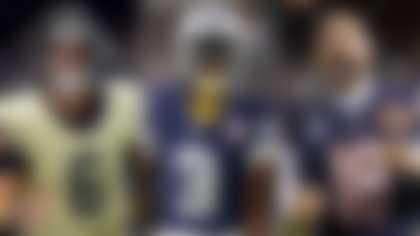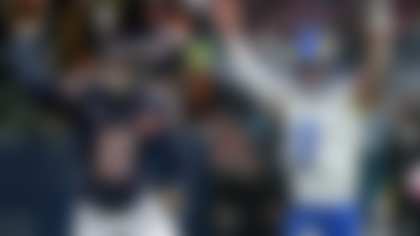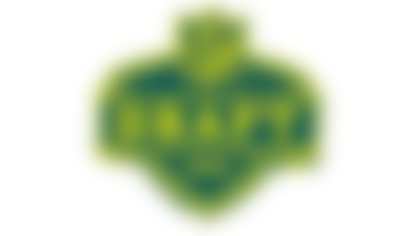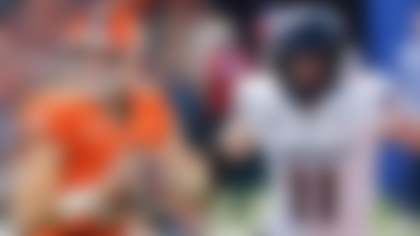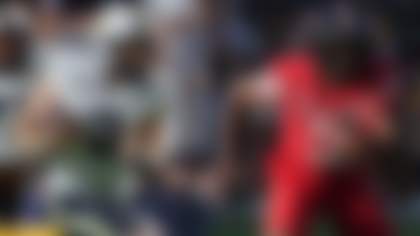The NFL playoffs are here again! And with another group of 12 teams about to begin the chase for a Lombardi Trophy, I've made another update to the mathematical model I use to predict Super Bowl participants.
Last year, I described model V2.0m, which predicts the outcomes of individual postseason games. This year, I've translated the V2.0m individual game predictions to the likelihood of eventual conference winners by simulating how the playoff bracket will play out based on individual matchup predictions. For clarity, we'll refer to this overall conference winner prediction as model V3.0, and refer to individual matchup predictions as model V2.0m.
Model V3.0 is more accurate than other models I've written about for predicting Super Bowl participants in past years. Its main advancement over previous iterations is more accurately incorporating the importance of home-field advantage and bye weeks. However, it is similar to previous versions in that it incorporates metrics made available by Pro Football Reference like expected points, offensive simple rating system (OSRS), strength of schedule, passing yards per attempt and defensive turnovers.
Before we jump to this year's prediction, let's turn a critical eye toward my models. For intra-conference postseason games (i.e., all of the games leading up to the Super Bowl), model V2.0m was at least 70 percent accurate in five of the last six years. It correctly predicted the winners of both conference finals last year (which contrasted the general consensus that the Vikings were favored over the Nick Foles-led Eagles):
In comparison, the "top seed" model (i.e., a simple yet sensible alternative method of picking winners based on the highest seed) only achieved 70 percent or better accuracy three times over the same time period. Both methods performed worst in 2015, which was a particularly tough year for predictions, as there was the most parity between teams compared to other years. (The parity between teams can be measured by computing the range of overall team strength. Interestingly, the 2019 playing field seems to be more balanced in comparison to recent years, suggesting some close finishes and potential upsets -- but more on that later.)
So, who will play in Super Bowl LIII?
Here are the 2019 V3.0 "chances" (i.e., probability of making Super Bowl LIII):
The V3.0 predictions confirm some widely held beliefs, but they also offer up some surprises. Let's dig in:
Thoughts on the AFC
-- The Kansas City Chiefs are the No. 1 seed in the AFC and thus hold home-field advantage throughout the playoffs, which is an important factor in model V3.0. They are the most likely to advance to Super Bowl LIII, considering their road to Atlanta will actually not take them away from Arrowhead, where they went 7-1 in the regular season this year.
-- The Chiefs have the highest point differential in the AFC, at plus-144. The next-highest point differential belongs to the Patriots, whose mark of plus-111 is 33 points lower than the Chiefs'. For the sake of comparison, consider that the difference between the NFC's highest point differential (the Saints' 151) and next-highest (the Rams' 143) is only eight points.
-- A potential weakness for K.C.: While the Chiefs' high-powered offense, led by budding sensation Patrick Mahomes, will likely put up plenty of points, based on their league-leading regular-season mark of 35.3 points per game, it's worth noting that the defense has given up the second most yards in the league (an important factor weakening their V3.0 chances) -- and that might be Kansas City's undoing.
-- The Patriots had the clearest path to the Super Bowl the last two years, and they capitalized on those opportunities. This year's path is tougher, and a loss for this perennial contender would be less surprising compared to 2016 and '17, given that their passing attack is a little less dominant in 2018, ranking eighth this season after ranking second last season and fourth in '16. Their total passing yards is incorporated in the model and produced lower chances than the last couple years.
-- The "sleeper" pick: Speaking of the Patriots being knocked off early, the Texans might be best poised to accomplish the feat. In fact, if they had earned a higher seed and were going to host potential games against the Patriots and Chiefs, model V3.0 would have designated them as the top AFC team. They have their top trio of offensive playmakers healthy: quarterback Deshaun Watson, receiver DeAndre Hopkins and running back Lamar Miller. Meanwhile, their defense, led by J.J. Watt and Jadeveon Clowney, has the most takeaways (29) on their side of the playoff bracket. Model V3.0 rewards balance on both sides of the ball, and the Texans are one of the most balanced teams, as evidenced by their top-five offensive mark in yards per pass attempt (8.2), and top-five defensive standing in points allowed (19.8).
-- It's tempting to get excited about the streaking Colts, who won nine of their last 10 to reach the playoffs after starting the season 1-5, but they've had one of the easiest schedules in the league, they're in the bottom third of the league in yards per pass attempt (7.1) and are one of the most penalized teams in the league. According to model V3.0, the chances of Indy putting together a three-game win streak on the road are worse than rolling snake eyes.
Thoughts on the NFC
-- The Saints are the favorites in the NFC, and, like the Chiefs, have been tough to beat at home (they went 6-1 in their last seven home games, with the one loss coming in Week 17, while multiple starters were resting).
-- The duo of Sean Payton and Drew Brees has consistently produced top passing numbers over the years, ranking in the top five in passing yardage from 2013 to '17. This year, however, the Saints ranked 12th in passing -- but they also led the league in rushing touchdowns and ranked sixth in rushing yards. This offensive recipe has led to the second best OSRS in the NFC, while New Orleans' defense was second in rushing yards allowed -- both of which contribute to a strong V3.0 prediction.
-- A potential weakness for New Orleans: The pass defense has been underwhelming and will need to avoid giving up big plays to secure the NFC title.
-- The Rams have appeared unstoppable at times throughout the season and piled up the most point in the NFC. Though, they've also benefited from an easier schedule than most other NFC contenders, which negatively impacts their V3.0 chances a bit. They will be missing a key player in receiver Cooper Kupp, who was lost in November. Stud running back Todd Gurley, meanwhile, has been less than 100 percent in recent weeks, though he had the last two weeks of the regular season to get right for the postseason. During the month of December, the Rams averaged 27.6 points per game, more than a touchdown less than their scoring average before then, suggesting their offense might be less potent than earlier in the season.
-- The "sleeper" pick: Dallas is the NFC team most likely to pull off an upset in the Divisional Round, based on the No. 4 seed's relatively high V3.0 chances. After receiver Amari Cooper joined via midseason trade, the Cowboys went 7-2 and apparently developed a recipe for winning close games, including against the top-seeded Saints in Week 13. That recipe seems to include defense, taking care of the football and discipline: Dallas has allowed the second-fewest points in the NFC, is top five in fewest turnovers lost and is one of the least penalized teams in the league. Combine that with solid -- if not spectacular -- offensive statistics (eighth in completion percentage, 10th in rushing yards), and the 'Boys field one of the more balanced teams in the tournament (like the Texans). Consequently, model V3.0 gives them a decent chance.
-- Interestingly, the Bears have low V3.0 chances (fifth out of the six NFC teams) despite having earned the No. 3 seed in their conference and possessing the stingiest defense in the league (ranked first in points allowed at just 17.7 per game). Part of the reason for the low prediction is that they have had one of the easier schedules and their offensive numbers are mediocre (17th in pass yards per attempt, 26th in rush yards per attempt and 24th in passing first downs). Additionally, the 2018 Bears have exhibited a high-degree of creativity and pulled off numerous trick plays, which often have an in-game impact that does not translate well to the stat sheet. This might be a case where the model is wrong, since it learns from the statistics of previously successful teams; it's possible model predictions might be off due the Bears' unconventional methods. They will likely have to continue their unorthodox ways in order to earn a trip to Atlanta.
When does the unlikely become more likely?
What about the approximately 30 percent of the time when the V2.0m predictions are wrong? I investigated many of the past incorrect predictions and uncovered some common themes:
-- One of the main factors in incorrect predictions: injuries to key players, which are always a risk in the NFL. One example that comes to mind from last year was the Titans' stunning second-half comeback to upset the Chiefs in the Wild Card Round. Of course, there are many factors that contributed to that outcome, but I believe a major one was Kansas City tight end Travis Kelce leaving the game.
-- Another major theme: underdog teams taking risks and executing them successfully. The "Philly Special" will be remembered for many years to come as a key play that helped propel the Eagles to victory in Super Bowl LII. (A less-remembered side note from that game is that the Patriots also attempted -- and failed -- a QB throwback.)
Fun football ahead!
As I mentioned above, the gap between the best and worst team heading into this year's playoffs appears to be lower than usual. In fact, the overall disparity between playoff teams is at its lowest since 2012. (The range in overall team strength computed by the model is about 20 percent lower than the previous minimum range in 2015, a year of numerous postseason upsets.) This is great for fans, as there should be some close games, exciting finishes, upsets and some creative plays (at least from Matt Nagy and the Bears, if no one else).
When the dust settles, the most likely scenario is a Chiefs-Saints showdown at Mercedes-Benz Stadium. The model predicts a fairly even matchup with a slight edge going to the Saints. Since it will be played at a neutral site, there is no true home-field advantage. However, the Saints -- and, especially, Brees and Payton -- have plenty of experience traveling east to play the Atlanta Falcons for the annual matchup against their NFC South rivals. If we assume the familiarity with playing in Atlanta and the better overall road record (7-1 vs. the Chiefs' 5-3) give the Saints the equivalent of a 10 percent home-field advantage, then the model's confidence would get an additional bump. While far from certain, the math indicates that the winners of Super Bowl XLIV are the favorites to once again bring the Lombardi Trophy back to the Big Easy.
Nasir Bhanpuri, PhD, is a clinical informatics data scientist at Virta Health based in San Francisco. He has been applying analytics and modeling techniques to address challenges in a wide range of fields, including sports, healthcare, nutrition, music, education, neuroscience and robotics.
